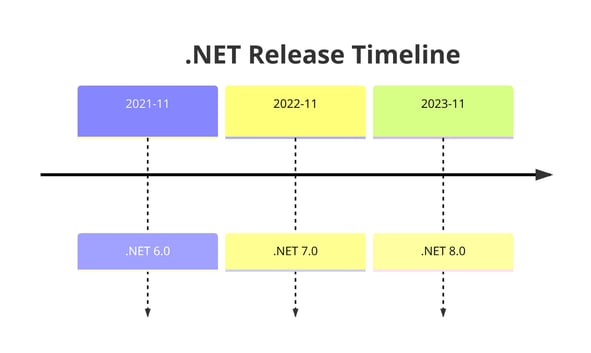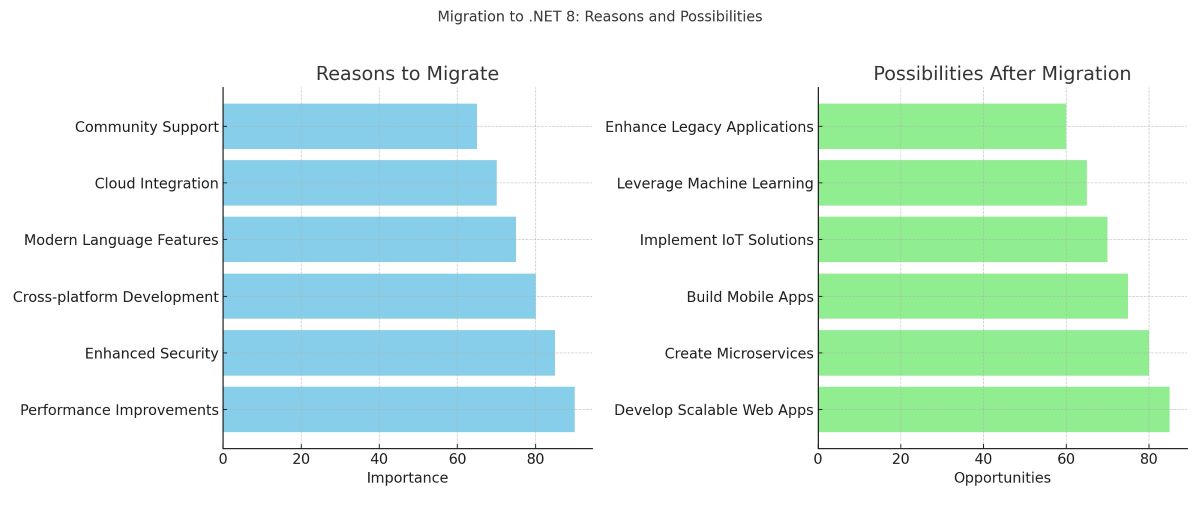How does .NET 8 revolutionize cross-platform development? How does it contribute to .Net's dominance over 25% of the development sector?
Microsoft’s .NET framework released .NET 8 in November 2023, continuing its tradition of annual updates and bringing significant enhancements and new features to its robust framework. The latest version underscores Microsoft's commitment to innovation and support for the developer community.
This evolution is particularly relevant in cross-platform development, where .NET 8 introduces features that streamline development processes, enhance performance, and ensure greater security across diverse platforms.
According to Statista, .NET frameworks and libraries are most used by developers. All the .NET techs also dominate over 25% of the development sector.
In November 2021, Microsoft released .NET 6.0; in November 2022, they released .NET 7.0; and in November 2023, they released .NET 8.0. Looking to hire .NET developers? Transform your project with the latest .NET technologies!

Cross-Platform Development
Cross-platform development allows developers to write code once and deploy it across multiple platforms, including Windows, Linux, and macOS. This approach has gained immense popularity due to its efficiency and cost-effectiveness. .NET 8, with its advanced features, is pivotal in facilitating cross-platform development, making it an invaluable tool for developers to build versatile and high-performing applications.
Feature of .NET 8 for Cross-platform development
#1. Garbage Collector Improvements
One of the most significant enhancements in .NET 8 is the Garbage Collector (GC) improvement. The GC now supports dynamic adjustment of an application's memory limit, which is particularly beneficial for cloud-native applications running on platforms like Kubernetes. This feature ensures that applications can manage memory more efficiently, improving performance and reducing resource consumption across different environments.
#2. JSON Enhancements
.NET 8 has introduced substantial improvements to JSON serialization and deserialization, including support for new numeric types like the half struct. This enhancement is crucial for applications that utilize hardware accelerators and Neural Processing Units (NPUs), aligning with the floating-point hardware. These improvements boost performance and ensure that .NET applications can easily exchange data across different platforms, fostering a more interconnected and seamless development ecosystem. Unlock the full potential of web app development with ASP.NET Core. Discover the top reasons why ASP.NET is the best framework – explore with us now!
#3. Randomness Tools
Introducing new tools to provide randomness in code is a boon for developers, especially in fields like machine learning, where randomness can be a critical factor in algorithms. This feature allows for the direct use of randomness as a selector, enhancing the functionality and reliability of machine-learning applications across various platforms.
#4. Cryptography Enhancements
With cyber threats becoming more sophisticated, the addition of SHA-3 support in .NET 8 is a timely update that enhances the security of .NET applications. This new feature provides an alternative to the widely used SHA-2, ensuring that applications remain secure against evolving threats. This enhancement is particularly significant for cross-platform development, where applications often face diverse security challenges.
#5. Silicon-Specific Features
.NET 8 introduces features built on the Intel AVX-512 instruction set, offering significant performance boosts for data processing-heavy applications. These silicon-specific features leverage the power of modern hardware, ensuring that .NET applications can perform optimally on various platforms, taking full advantage of the underlying hardware capabilities.
#6. Time Abstraction
The new time abstraction feature addresses the challenge of time-related bugs, which can be elusive and difficult to manage. This feature allows local time providers to operate across different time zones, simplifying time handling in cross-platform applications. This is a significant enhancement for developers working on global applications, where accurate time management across time zones is essential.
5 Most Popular Use Cases Of .Net 8 In Cross-Platform Development
.NET 8, the latest iteration of Microsoft's .NET platform, brings many features and improvements that make it a compelling choice for various cross-platform development scenarios. Below are five widespread use cases where .NET 8 shines, especially in cross-platform environments:
#1. Microservices Architecture with Docker:
Use Case Description: .NET 8 facilitates the development and deployment of microservices architectures by offering robust, scalable, and flexible solutions that can be containerized with Docker. This approach allows developers to build applications as a collection of small, independent, and loosely coupled services. Each microservice can be developed, deployed, and scaled independently, enhancing agility and efficiency.
Benefits: Improved scalability and resilience, easier maintenance, and faster deployment cycles. The integration with Docker simplifies container management, enabling seamless deployment across different environments and platforms.
Choosing between .NET Core and .NET Framework for your app development? Dive into our comprehensive comparison to make an informed decision today!
#2. AI and Machine Learning with ML.NET:
Use Case Description: .NET 8 supports AI and machine learning applications through ML.NET, an open-source and cross-platform machine learning framework. Developers can leverage ML.NET to create, train, and deploy machine learning models for applications ranging from predictive analytics to image classification, all within the familiar .NET ecosystem.
Benefits: Enables the integration of machine learning into .NET applications without needing to learn a new programming language or framework, facilitating the development of intelligent applications across various platforms.
#3. Cross-Platform Mobile Development with MAUI:
Use Case Description: .NET Multi-platform App UI (MAUI) is a framework in .NET 8 that allows developers to build native mobile and desktop applications from a single codebase. This framework supports Android, iOS, macOS, and Windows, making it ideal for cross-platform mobile app development. Discover why .NET MAUI is the top choice for your app development projects. Learn more and lead the way in innovation with us!
Benefits: Increases code sharing and reduces development and maintenance costs. It also leverages native device capabilities, ensuring high performance and a native user experience across all platforms.
#4. IoT Applications:
Use Case Description: .NET 8 extensively supports building Internet of Things (IoT) applicati.ner frameons. With its cross-platform capabilities, developers can create software that runs on various IoT devices, including those based on Windows IoT, Linux, and others. The framework supports the development of both the device-side and cloud-side software, enabling comprehensive IoT solutions.
Benefits: Streamlines the development of IoT applications with support for a broad set of devices. It facilitates the integration with cloud services for data processing and analytics, enhancing the capabilities of IoT solutions.
#5. Desktop Applications with Cross-Platform Support:
Use Case Description: .NET 8 continues to support the development of powerful desktop applications with frameworks like Avalonia and Uno Platform for cross-platform solutions. These frameworks enable the creation of applications that can run on Windows, Linux, and macOS from a single codebase, leveraging the .NET ecosystem's power and flexibility.
Benefits: Facilitates the development of visually appealing, high-performance desktop applications that can reach a wider audience by running on multiple operating systems. It reduces the complexity and cost of developing and maintaining separate applications for each platform.
Each use case demonstrates the versatility and power of .NET 8 in supporting diverse application development needs across multiple platforms, leveraging the latest technologies in microservices, AI/ML, mobile development, IoT, and desktop applications.
Migrating to .NET 8
Migrating to .NET 8 from previous versions involves a systematic approach to ensure a smooth transition. Developers should start by assessing their current applications for compatibility issues and updating their projects to target .NET 8. Utilizing the .NET Upgrade Assistant can simplify this process, automating many of the steps involved in the migration. It's also crucial to thoroughly test applications after migration to identify and address any issues arising from the new features and improvements in .NET 8.

The graph illustrates the reasons for migrating to .NET 8, the possibilities that such a migration can unlock for software development, and various use cases. On the left, the reasons for migration include performance improvements, enhanced security, support for cross-platform development, the introduction of modern language features, better cloud integration, and strong community support. On the right, the possibilities after migrating to .NET 8 encompass developing scalable web applications, creating microservices, building mobile apps, implementing IoT solutions, leveraging machine learning, and enhancing legacy applications. Each factor is rated based on its importance or the opportunities it presents, providing a visual representation of why and how moving to .NET 8 can benefit software development projects.
A Table Of Comparison: .Net 8 Vs. Other Frameworks
When comparing .NET 8 with other frameworks for cross-platform development, it's essential to consider various factors such as performance, language support, ecosystem, tooling, and community support. Below is a comparison table featuring .NET 8 and some of the most popular cross-platform development frameworks as of my last update in April 2023. Note that the technology landscape evolves rapidly, and specifics may have changed since then.
|
Feature |
.NET 8 |
Flutter |
React Native |
Xamarin |
|
Supported Platforms |
Windows, Linux, macOS, Android, iOS |
Android, iOS, Web, Windows, Linux, macOS |
Android, iOS, Web, Windows (via extensions), macOS (via extensions) |
Android, iOS, Windows, macOS |
|
Primary Programming Language |
C#, F# |
Dart |
JavaScript, TypeScript |
C# |
|
Performance |
High, with native performance on all platforms due to ahead-of-time (AOT) compilation for mobile and just-in-time (JIT) for web and desktop. |
High, with AOT compilation and a highly optimized rendering engine. |
Good, with performance slightly hindered by the JavaScript bridge. |
Good, with direct access to native APIs but slightly hindered by the mono runtime layer. |
|
Ecosystem |
Extensive, with a large library of NuGet packages for various needs. |
A rich ecosystem with a growing set of Flutter-specific packages. |
Massive benefits from the extensive NPM package ecosystem. |
Large, supported by all .NET libraries plus Xamarin-specific packages. |
|
Tooling |
Visual Studio, Visual Studio Code, JetBrains Rider, and others. |
Flutter SDK with command-line tools and Dart DevTools for debugging and profiling. |
React Native CLI and Chrome DevTools for debugging. |
Visual Studio with Xamarin tools integrated, Visual Studio for Mac. |
|
UI Development |
Flexible, with support for both native and custom UI development across platforms. |
Widget-based, highly customizable, and expressive UI components. |
Component-based, with a rich set of community-developed UI libraries. |
Uses native UI controls, allowing for a native look and feel on each platform. |
|
Learning Curve |
Moderate, especially for those familiar with C# and the .NET ecosystem. |
Moderate Dart is easy for JavaScript or Java developers, but understanding the widget and state management concepts can take time. |
Moderate, requires knowledge of JavaScript and the React framework. |
Moderate to high, requires knowledge of C# and .NET, plus an understanding of mobile development concepts. |
|
Community Support |
Large, with extensive documentation, tutorials, and community forums. |
Proliferating, with a supportive community and a wealth of resources. |
Very large and supported by a vast community and Facebook. |
Significant, especially since it's part of the broader .NET community. |
This table is a starting point for evaluating which framework best suits your cross-platform development needs. Each project's unique requirements, such as the target audience, performance needs, and development team's expertise, will significantly influence the choice of the framework.
Conclusion
The release of .NET 8 marks a significant milestone in the evolution of the .NET framework, offering many features and enhancements that bolster cross-platform development. From garbage collector improvements to cryptography enhancements, .NET 8 equips developers with the tools to build efficient, secure, high-performing applications across diverse platforms. As developers continue to embrace cross-platform development, the significance of .NET8's facilitation of this approach cannot be overstated. With its advanced features and enhancements, .NET 8 is set to play a pivotal role in the future of software development, enabling developers to meet the challenges of an increasingly interconnected and digital world.
Author







